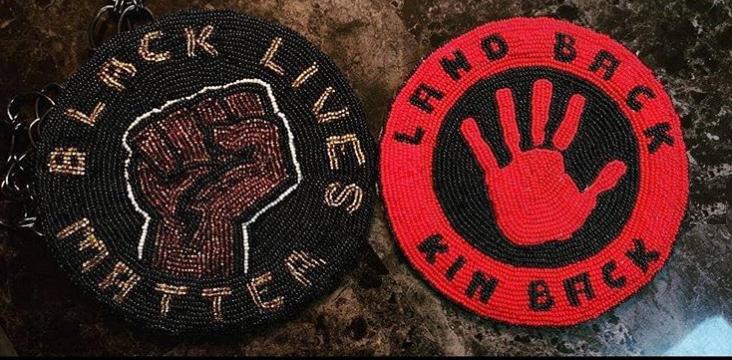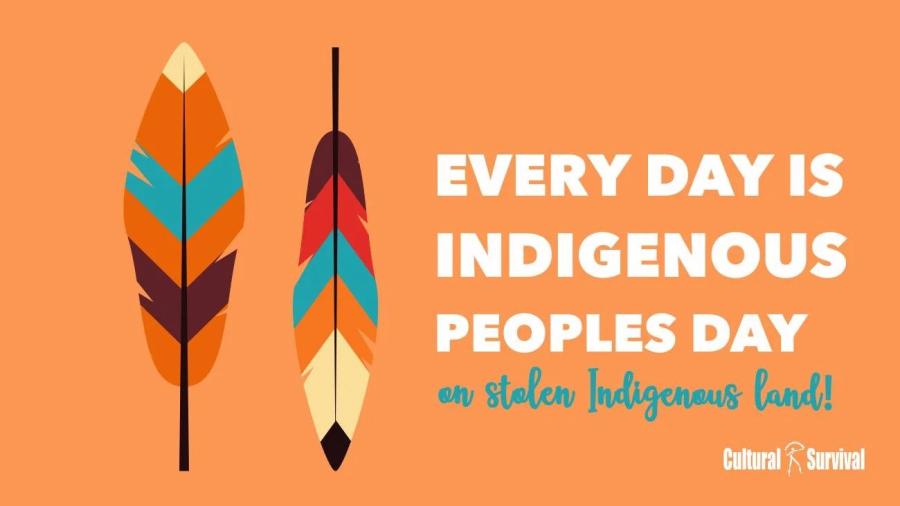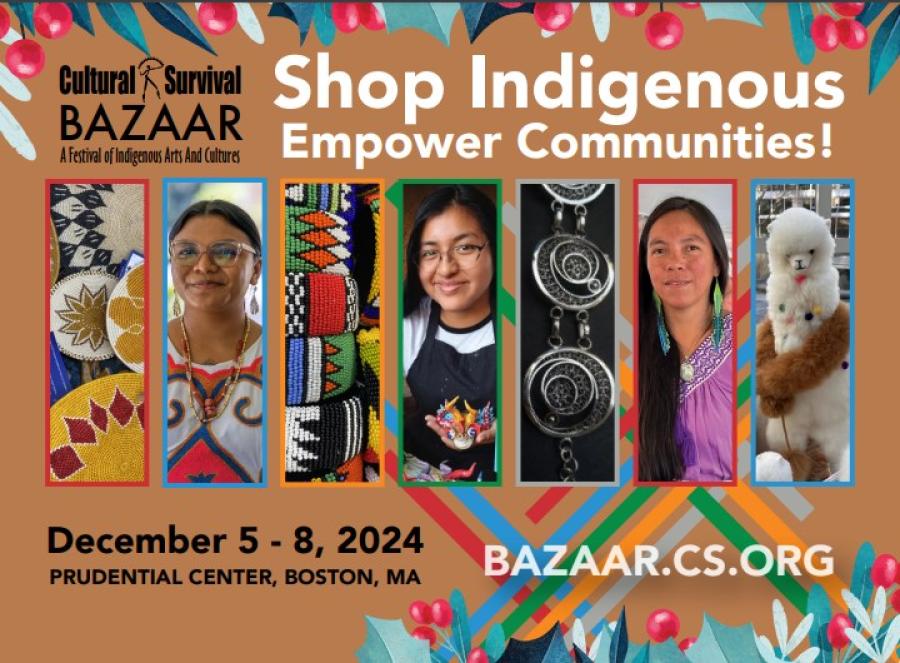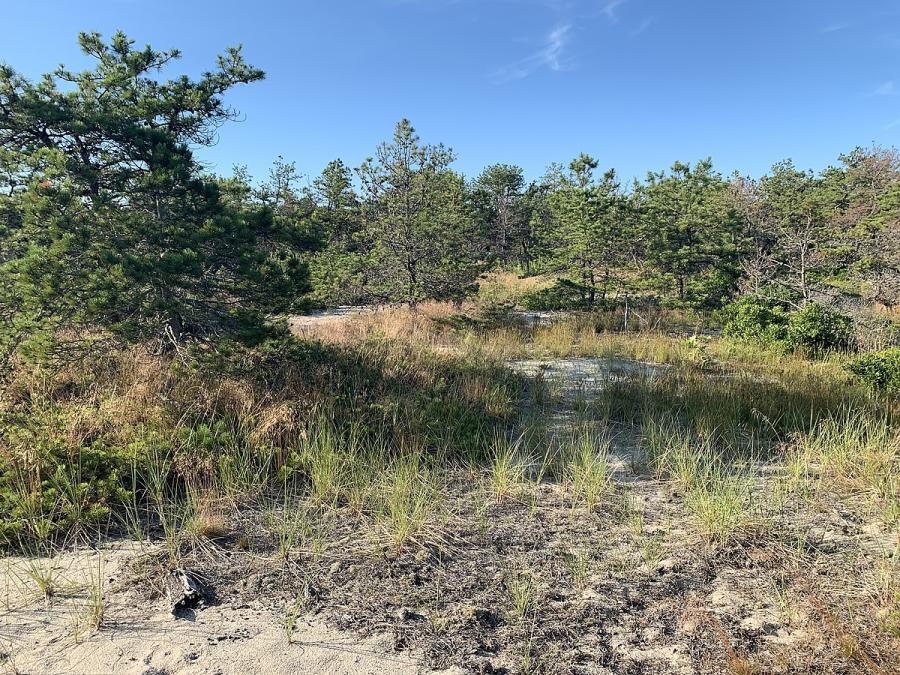
By Erica Belfi. Beadwork and photo by Wapahkesis.
The fight against police brutality is nothing new to Indigenous people. In Minneapolis and beyond, Native Peoples have joined in on the demonstrations with Black Lives Matter protesters, yet again mobilizing in a centuries-long movement against state violence. Approximately 150,000 Native Americans live in the Minneapolis area today, a number that rose after the U.S. government began moving them off of their reservations in the 1950s and enacting termination and relocation policies. Katrina Phillips, a member of the Red Cliff Band of Lake Superior Ojibwe and an assistant professor of history at Macalester College, noted the significant presence of Native Americans at the protests. “Why was it important that American Indians joined the protests in solidarity with African Americans? Because their presence underscores Minneapolis’s ongoing hostilities against Indigenous people and people of color and highlights the long history of weaponized state violence against American Indians,” Phillips stated.
While Indigenous people are coordinating responses and protesting, many affirm that they are there to center Black people and support the work that Black activists are already leading against police brutality. Idle No More organizers Nickita Longman, Shawn Johnston, and Alex Wilson stated that “Black activists have supported the resiliency of Indigenous people time and time again. It is our turn to show up, take instruction, and trust in the Black Lives Matter movement at this time, and always.”
Many Indigenous-led organizations are expressing solidarity and committing to the movement, citing the ways in which “Indigenous Sovereignty and Black Liberation go hand-in-hand.” The Indigenous Environmental Network, for example, asserts that the same extractive and exploitative colonial powers, along with structural racism and the “concentration of wealth and power among the few” are what have contributed to the oppression of both Black and Indigenous people. “In this moment we lift up and center Black voices and the Black Lives Matter movement. This does not mean that police brutality inflicted upon Native communities is any less crucial to address. It does not mean that our struggles are any less important. In fact, standing in solidarity and supporting Black Lives Matter, addresses the root causes of that brutality - systemic racism and white supremacy,” the group stated. “Dismantling these systems is the work we need to do together.”
Indigenous protesters cite the history of police violence against their communities as part of why they stand in solidarity with Black organizers. On June 4th, 2020, Chantel Moore, a 26-year-old woman from the Tla-o-qui-aht First Nation, was shot and killed by police during a wellness check in Edmundston, New Brunswick. Moore had dreams of becoming an engineer and moving to New York City. She was also a mother. Police officials reported that officers at the scene did not attempt to use non-lethal force and were not equipped with body cameras. Everett Patrick, a 42-year-old father and member of the Lake Babine Nation, died in police custody on June 2, 2020. Though the police force reports that they cannot disclose what happened to him while he was in custody, his family questions the injuries that led to his death in Burns Lake, British Columbia. Eishia Hudson, a 16-year-old, was shot and killed by police in Winnipeg on April 8th, 2020. Police shot her when she was in a stopped car with several other teenagers after officers alleged that she helped rob a liquor store. Her parents describe her as athletic, big-hearted, and persistent, noting that she was excited about graduating next year. Having seen the news about the incident, Hudson’s family spent six hours trying to contact authorities before they were finally notified of her death.
The violence is compounded for Afro-Indigenous people. Though she received relatively little press coverage, Regis Korchinski-Paquet was killed in an encounter with Toronto police on May 27th, 2020. Korchinski-Paquet was 29 years old and an Afro-Indigenous Mi’kmaq woman. She was a talented gymnast and was often active in her church. She had occasional epileptic seizures, for which her family had called the police in the past to get Korchinski-Paquet help. However, when a family member called police to de-escalate a family dispute in May, six officers showed up and entered the family’s apartment, forcing everyone but Paquet to stay outside in the hallway. Korchinski-Paquet’s mother heard her cries from inside the apartment, reporting that officers had her daughter cornered on the balcony and pushed her off of the 24th floor, killing her. Many contend that the manner in which she died and the lack of national media coverage can be attributed to her identity as an Afro-Indigenous woman.
Studies suggest that the actual number of Black and non-Black Indigenous Peoples who are killed by police is uncertain, given that underreporting is common and deaths-by-police in Native communities are rarely picked up by mainstream media outlets. The problem is likely much worse than is statistically visible. Researchers affirm that part of the problem is due to identification. After Daniel Covarrubias (Suquamish Nation) was shot and killed by police in 2015 when he reached for his cell phone, the New York Times initially misidentified him as Latino. Many police precincts do not consistently report race or ethnicity at all, simply listing people killed by police as ‘unknown’. Furthermore, cases are usually separated in Black or Indigenous categories, neglecting to recognize people who are Afro-Indigenous or mixed. Whether it is due to misidentification or lack of clear, disaggregated data, structural racism perpetuates the legacy of colonial oppression.
In response to the state violence and in support of the Black Lives Matter movement, Indigenous people are mobilizing in different ways. Many organizations have taken a stand with Black folks against the settler state, relaying messages of solidarity. Members of the Native Women Lead (NWL) coalition are asking people to avoid co-opting the movement and to instead center Black people. In their call to action, they also ask non-Black Indigenous people to acknowledge the anti-Blackness in themselves, their families, and their communities. An analysis of the relationship between Black and Indigenous people reveals a complicated past, including a painful history of some Native American communities enslaving Black people.
Phillips contends that the Indigenous presence we see at Black Lives Matter protests is here to stay. “The protesters marching in Minneapolis who carried burning sage, [American Indian Movement] flags and hand drums in a powerful demonstration of solidarity and support, the people mobilizing to provide resources, the jingle dress dancers who honored [George] Floyd the next week and the protectors who stand guard every night draw on decades and centuries of Indigenous resistance against state violence aimed at their communities and their neighbors.” she states. The state violence that Phillips references is intertwined in the histories of Black and Indigenous people. With a violence so deeply grounded in racism and bigotry, collaboration may be the best way to eliminate it.
Ciann Wilson, a Black assistant professor at Wilfrid Laurier University in Waterloo, remarks that the oppression that Black and Indigenous people are fighting against is ultimately a result of white supremacy. Wilson has served as the principal investigator for the Proclaiming Our Roots project, which works to explore the histories of Black and Indigenous communities, especially in relation to Afro-Indigenous people. She notes that “[w]hen Indigenous and Black people have gotten together throughout history in the North Americas, they have staged some of the biggest threats to colonial rule.” Wilson describes how, for example, the Haitian revolution against French colonial power and slavery can partly be attributed to the collaboration between Black, Indigenous, and Afro-Indigenous people. The groups founded an alliance again to prevent further displacement of Indigenous people during the Seminole Wars in 1800 Florida. Wilson gives testament to the power of coordinating the movement in its rejection of white supremacy.
In the late 1960s, Indigenous activists and communities began the American Indian Movement (AIM) Patrol, a group of Native Americans who maintain neighborhood safety and provide a buffer between Native communities and police. AIM was founded in Minneapolis in response to police violence and has recently gathered at the protests to provide security and protect the people there. The idea was that “[w]ithout police, communities can maintain their own safety with less brutality and more accountability.” AIM Patrols can monitor neighborhoods themselves, intervening in situations with police that look like they may escalate. Their duties may also include escorting people home, cooking breakfast for people experiencing housing insecurity, doing check-ins on neighbors, and “sitting with those who might hurt themselves.” Tall Paul (Ojibwe and Oneida), a member of the patrol, believes that a more localized approach to neighborhood safety can help reduce police violence. “If it’s a mental health crisis, I feel like an armed cop shouldn’t be coming, because they’re gonna come with a warrior mentality,” Paul stated. “Mental health workers could be called. If there’s an overdose, a medic could be called. It shouldn’t just be ‘cops or nothing.’” But with few resources, “people don’t know who to call besides 911.”
Community policing can also have its own dangers in areas where racism and bigotry are most prevalent, as an article in Mother Jones lays out. Trayvon Martin, a 17-year-old African American teen from Florida, was shot and killed by a racist neighborhood watch volunteer who was empowered by his perceived authority. While some neighborhoods have experienced success with neighborhood patrols, it is not a perfect solution. Reinforcing communities with mental health and other welfare resources may alleviate some difficulties, but others contend that “the social work institution has its own racist tendencies.” This discussion leads some people to believe that the act of policing, itself, in addition to racism, is the core of the problem.
Hundreds of years of compounded violence and trauma against Black, Indigenous, and Afro-Indigenous people has culminated in an immense loss of life. The current protests are just one way that Indigenous Peoples are mobilizing to continue to challenge state-sanctioned violence and entrenched racism against Black people. “As we continue to fight back in solidarity against colonization and white supremacist ideologies, we acknowledge the need to confront the anti-Black racism that exists within our own communities, in our families, and within ourselves,” states the Indigenous Environmental Network. “We pledge to embrace the ways in which our histories and families have been forever linked by blood, struggle, and love. We pledge to do the challenging work to build deeper solidarity. Our struggles are intertwined with each other.”



